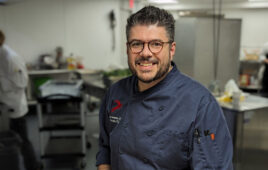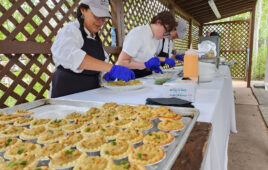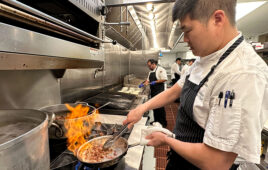 Mobile dining is on the move—literally. A trend that took off during the height of the pandemic, when outdoor dining enabled clubs to remain open and provide a safe service, has since morphed into a more permanent F&B fixture. Food trucks have been tasked to take on member events and pick up some of the overflow when club kitchens are at their busiest. Here’s how some facilities are getting extra mileage out of their on-the-go eateries.
Mobile dining is on the move—literally. A trend that took off during the height of the pandemic, when outdoor dining enabled clubs to remain open and provide a safe service, has since morphed into a more permanent F&B fixture. Food trucks have been tasked to take on member events and pick up some of the overflow when club kitchens are at their busiest. Here’s how some facilities are getting extra mileage out of their on-the-go eateries.
Street Eats
Providing membership with another dining option in a convenient format was the goal of Woodfield Country Club in Boca Raton, Fla.
“The food truck offered efficiencies and flexibility compared to a standard restaurant outlet,” says Executive Chef Bart Messing. With a focus on street food options, the aptly named Street Side truck opened in 2019 and has since generated a robust, revolving menu of dishes.
Converting a truck for foodservice made sense for Woodfield, and Street Side stays on property. The menu includes smash burgers, a Korean fried chicken sandwich, a cauliflower bowl and challah grilled cheese.
“We avoid offering traditional favorites available in other club restaurants,” says Messing. A recent pop-up converted Street Side into a dessert and ice cream truck, while another focused on tacos and smash burgers.

Woodfield CC’s Street Side food truck offers a revolving menu of street food-inspired dishes, including tacos (pictured), smash burgers and a Korean fried chicken sandwich.
Assigning sufficient staff is essential to a successful food truck. A dedicated team of two cooks and two or three front-of-house employees are on-hand to serve 150-200 members at any time. A food attendant is stationed outside the truck to take orders on a wireless tablet.
Because prep and cook space is limited, Messing and his crew rely on a carefully laid out operation, particularly during peak hours. “The truck offers traffic flow benefits at lunchtime on weekends and holidays, especially winter breaks,” he says.
Street Side will feature new pop-up themes that build off the existing menu for the upcoming season. Down the road, the truck may offer catered services at member homes, but plans have not yet been finalized.
The Making of a Legend

Ashely Davidson, co-owner of The Legendary Food Truck in Franklin, Ind., knows the ins and outs of food truck service. When she and her husband, Ted, first considered bolstering dining options at Legends Golf Club (where Ashely handles member events and weddings and Ted manages the golf shop and facilities), they contemplated expanding the existing kitchen, but it wasn’t practical.
It was then that Davidson suggested starting a food truck. Seven years later, the Davidsons have established a successful food truck venture that has expanded its services beyond club grounds and become a destination for Indianapolis foodies.
“We have become known for our hand-breaded pork tenderloins, which are a Hoosier tradition,” she notes. “We also offer items people would order at the club—like Arnold Palmers and chicken salad.” She and Ted are responsible for preparing and expediting the food, while a staffer handles orders and the cash register. Occasionally, a banquet or snack bar team member may be called to assist.
Once the truck’s initial output ramped up, Davidson realized it would be more economical to move the core business off-property. “We find that we can do more in a couple of hours off-site than at the club,” she explains, noting that the 27-hole, semi-private club plays about 48,000 rounds per year. “Even with that traffic, our food truck wasn’t maximizing its potential on-site.”
The truck began taking on large events and fine-tuning the menu to limit the number of entrées for greater efficiency. Davidson also tailored the work schedule to take on outside events that work around the production schedule. Jobs that didn’t amass enough revenue to compensate for staff and prep—and required trekking into the city multiple times a week—have prompted her to be more selective. “We’ve worked hard to build a business closer to the club,” she says, “so we can take the truck out less and make more.”
These days, Legendary Kitchen is taking on events that allow it to serve concert-goers at a local amphitheater. During a recent event, the truck fed 460 people in five hours. “We find ourselves there as often as we’re at the club,” says Davidson. She advises facilities to use their own trucks “at the club when it makes sense, but also build a reputation within the community.”
Keep on Truckin’
What began as a way to offload the main kitchen and balance foodservice at Indian Trail Club has become a popular member attraction.
Four years ago, the Franklin Lakes, N.J., facility established a food truck with this goal in mind. “As the [clubhouse] restaurant became busier, it was clear that the kitchen line would have to be dedicated to a la carte service only,” says Jeff Habley, CEC, Executive Chef.

Indian Trail Club’s truck is staffed by a mix of full-time cooks and seasonal employees.
Indian Trail’s truck is staffed by a mix of full-time cooks and seasonal employees (see photo, top right). In addition to standard service, it recently came in handy during Indian Trail’s Taste of the Private Club Chefs event. “We used our truck as a departing station from which we sent guests home with a bag containing a hot breakfast sandwich, drink and dessert,” says Habley.
Initially, the menu consisted of kid-friendly items like chicken tenders and hamburgers but has evolved to include food truck favorites like empanadas, fish tacos and açaí bowls. Appealing to the adult crowd, the truck offers draft beer, wine and canned cocktails.
While the intent was to station the truck at locations on the property, it simply wasn’t feasible, as it was the main F&B outlet for the pool, explains General Manager Michael Azbill. Instead, the club is considering a secondary mini truck to work with the main truck, providing grab-and-go items around the tennis courts, softball area, beach and boating spots.
A dedicated manager is essential for supervising truck-related activities, says Habley, as is a plan for days when it’s too hot to operate in the truck. “We set up an outside grill under the shade and run a limited menu,” he says. Space for employees on break is another must.
“Make sure you have the proper kitchen equipment in the right places to run a fast and efficient food truck,” adds House Manager Turgay Itez, who recommends iPads and wireless routers. And when developing a menu, be sure to have the right tools and resources for foolproof production.
“If you want soft-serve ice cream, allocate enough power to operate that equipment,” says Habley. “You can’t add equipment as an afterthought with limited power.”




